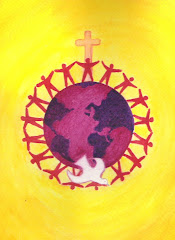exhibited in the sanctuary. Perhaps I should explain why it was there
and also take the opportunity to flesh out some of the details.
On 14 July I was asked to lead a party of about twenty from the New
Orleans Baptist Seminary, Louisiana, on a tour of Baptist historical
sites in Edinburgh and Leith. While I have often taken small groups on
walking tours down the Royal Mile and thereabouts, this was the first
time I had such a large party. Fortunately they had hired a minibus and
we had a local driver. What I had not taken into account, however, was
the weather, pouring rain, road works with the resulting traffic
diversions, and the Queen was in residence at Holyrood, so the
approach to that section of the Canongate was closed for security
reasons. Another problem was, as a non-driver, I was not fully aware
of one-way streets or pedestrianised sections in planning our itinerary.
Despite these setbacks, we covered a lot of ground, including some
general Edinburgh history, with the whole tour lasting over four hours.
I thought Bristo would make a good stopping off point, given our
history as the original Scotch Baptist Church. I chose the items on
show to give a brief portrait of Bristo over the years.
The picture on the front of the August issue showed the laying of the
foundation stone of our present building on 25 October 1933. Of the
two men officiating, on the right is Percival Waugh, our last lay pastor
who served in that capacity from 1903 to 1923, although remaining a
member of the church. This laying of the foundation, or memorial,
stone was his final public service for Bristo. He died in 1934, aged
eighty. The other, on the left, is Bailie John McMichael, the senior
deacon. (For the non-Scots among us a bailie was a member of the
town council who presided over the burgh court, equivalent to a
magistrate in England). Between these two men is George Yuille, who
had been pastor of Stirling Baptist Church, his only charge, from 1870
to 1913 and Secretary of the Baptist Union of Scotland from 1880 to
1919. (Yes, the dates did overlap!) He also served as the BU president
from 1902-03, the only serving Secretary to have held that honour.
George Yuille’s last public appearance was to dedicate the new Bristo
building on Wednesday 20 February 1935. (See p.15 of the August
issue). Yuille died on 18 December that year, aged ninety. While
Bailie McMichael had been present at these opening services, he died
suddenly on the following day, having served the church for sixty
years, forty-five of which were as a deacon. His death must have cast a
shadow over the first Sunday services in the new church.
The love feast, the accounts for which had been displayed, had a very
practical purpose. It took place between the morning service at 11 a.m.
and the weekly communion service at 2.30 p.m., which was at that
time for members (baptised as believers) only. In the days before cars
and buses, it was impossible for those who lived a considerable
distance from the church to get home between these services. So the
love feast met their bodily needs as well as giving the opportunity for
fellowship and exchanging news of members who may have been ill.
The accounts also give the historian a great deal of information on the
ordinary household diet from the late eighteenth to late nineteenth
centuries.
We finished our tour with a visit to Archibald McLean’s grave in St.
Cuthbert’s churchyard. Go down the main path to the church from
Lothian Road, just before the watchtower on the corner, and his
gravestone is on the right side almost diagonally opposite David
Dickson’s memorial fresco on the wall of the church. The badly worn
inscription is now barely legible but I was able to decipher it:
Died 21 December AD 1812 Aged 79 years
Mr Archd. M’Lean who was one of the original pastors of the first
Baptist church in Edinburgh and who devoted the great endowments
of which he was possessed to the work of the ministry, with unwearied
assiduity and zeal for the period of fortyfive years when he fell asleep
in Jesus. But although dead he yet speaketh in the many valuable
writings he has bequeathed to the community.
Mr Archd. M’Lean who was one of the original pastors of the first
Baptist church in Edinburgh and who devoted the great endowments
of which he was possessed to the work of the ministry, with unwearied
assiduity and zeal for the period of fortyfive years when he fell asleep
in Jesus. But although dead he yet speaketh in the many valuable
writings he has bequeathed to the community.
To his memory this stone is erected with sentiments of the highest
respect and affection by the ministers of the church over which he so
long and so earnestly presided.
His remains are interred one hundred feet to the south-east of this
stone.
In the next issue I will tell you something about the Mutual
Improvement Society.
(A question, mainly for the children: Why do we see watchtowers in
many of our old graveyards? Let me have your answers when you get
this magazine)
Christine Lumsden
